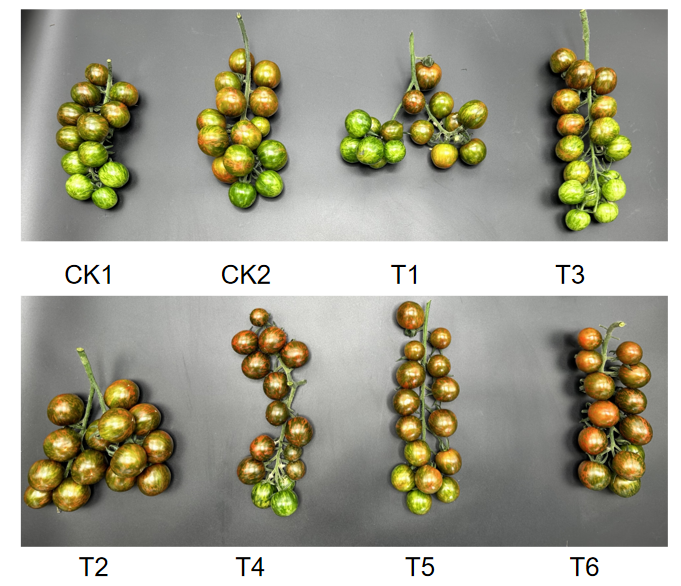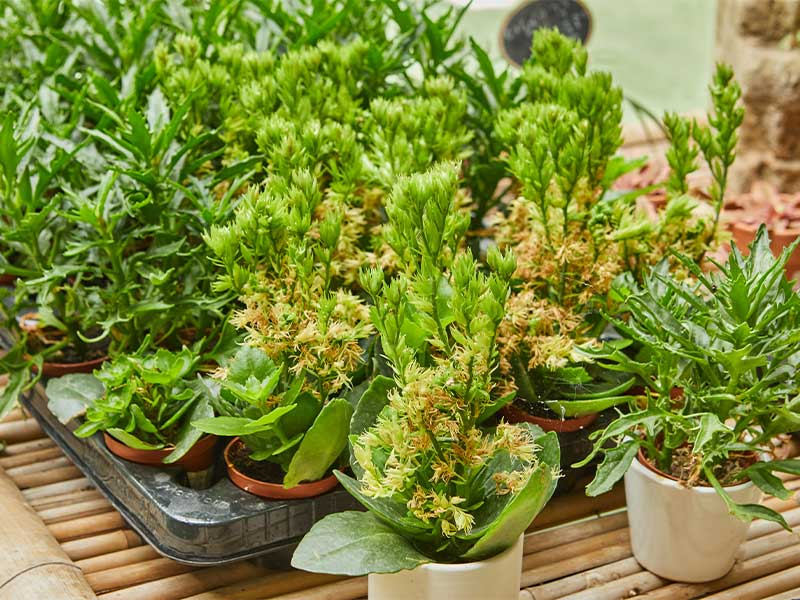Light is essential for plant growth, impacting everything from photosynthesis to the quality of the fruit produced. This underscores a crucial question: Is supplemental lighting necessary, and what impact does it have on crop development?
To investigate these issues, we conducted an experiment on tomato plants, focusing on the effects of ultraviolet (UV), infrared (IR), and Deep Red lighting.
Experiment Setup
Our goal was to assess how different types and combinations of supplemental lighting influence tomato growth. We chose a single variety of tomato, dividing it into eight groups. Each group was exposed to distinct lighting conditions using the FC-6500 system. Here’s a breakdown of the lighting regimens for each group:
- Main Lighting Schedule (FC-6500): Active from 5:30 AM to 5:30 PM.
- UV Lighting: Initially, UV lighting was applied for 5 minutes each hour from 5:30 AM to 5:35 PM during the first five days. Afterward, the duration was increased to 10 minutes per hour from 5:30 AM to 5:40 PM.
- IR Lighting: IR lighting was used for 15 minutes both before and after the main lighting period, from 5:15 AM to 5:30 AM and from 5:30 PM to 5:45 PM.
- Deep Red Lighting: This was continuously used throughout the main lighting period from 5:30 AM to 5:30 PM.
Growing Conditions
To precisely measure the impact of the various lighting treatments, all groups were grown under consistent environmental conditions:
- Temperature: Maintained between 22°C and 28°C.
- Humidity: Kept between 65% and 75%.
- Soil Composition: A blend of peat moss, perlite, and vermiculite in a 3:1:1 ratio.
These controlled conditions were crucial to ensure that any observed differences in plant growth, yield, and quality could be directly attributed to the different lighting treatments applied.
Experiment Results After 106 Days
1. Fruit Color Development:
- Observations: Images clearly show that red light treatment speeds up fruit development and facilitates faster color change, unlike UV light, which does not produce these effects.
- Red Light Effects: Red light significantly hastens fruit development and color transition, making it distinct from UV light.
- IR and Deep Red Combination: The combination of infrared (IR) and deep red light greatly accelerates fruit maturation. This leads to earlier ripening and a faster shift to ripe coloration, aligning fruits more closely with market preferences for readiness and vibrancy.
- Enhanced Pigmentation: The deepened coloration signifies the fruit’s readiness for harvest and meets market demands for brightly colored, vibrant tomatoes.
- Mechanisms: IR light deeply penetrates plant tissues, enhancing growth and maturation, while deep red light specifically intensifies the pigment changes associated with the ripening process.
2. Sugar Content:
- General Findings: Data shows that higher light intensities encourage the accumulation of sugars. The use of UV and deep red light significantly boosts this effect, producing sweeter and more flavorful tomatoes.
- UV Impact: UV light promotes the production of secondary metabolites like flavonoids, which enhance flavor.
- Deep Red Impact: Deep red light increases photosynthesis and sugar buildup by elevating carbohydrate production within the plants.
3. Yield:
- Enhanced Fruit Quality and Yield: Combining UV and deep red lights with standard lighting protocols, such as the FC-6500, not only augments fruit quantity but also enhances overall quality. This synergy between UV and IR light yields larger fruits with improved coloration, essential for market appeal.
- Promotion of Flowering in Short-Day Crops: While IR light has limited effects on day-neutral crops like tomatoes, it significantly enhances flowering in short-day crops like strawberries and cannabis. This could lead to a higher fruit set and increased yields. A separate experiment using the Adlite IR series, which emits 730-745 nm IR light, is considered to further explore this effect.
- Consistent and Reliable Results: The use of supplemental lighting consistently improves crop yield and quality relative to baseline conditions without supplemental light. Even though high-intensity light naturally boosts yield and quality, adding UV and deep red light consistently delivers superior results in terms of fruit weight and development.
The Impact of UV Light on the Cultivation of Herbaceous Plants
Our research underscores the vital role of supplemental UV lighting in enhancing plant growth, as detailed in studies such as "The Impact of UV Light on the Cultivation of Herbaceous Plants." This research emphasizes the positive effects of UV-A and UV-B light in several key areas of herb cultivation:
1. Enhanced CBD and Terpene Production: UV-A and UV-B rays significantly elevate the production of CBD and terpenes by increasing the density of trichomes on the surfaces of plant leaves. These trichomes serve not only as reservoirs for CBD but also synthesize natural compounds that offer protection against UV radiation. The result is herbs that are more potent and aromatic, delivering enhanced flavor and increased medicinal benefits.
2. Robust Pest and Disease Resistance: UV light prompts plants to produce specific defensive compounds that naturally ward off pests and prevent fungal infections. This biological protection decreases the dependence on synthetic pesticides, fostering more sustainable and organic agricultural practices.
3. Desirable Plant Morphology: Exposure to UV light modifies the physical structure of herbaceous plants, promoting more compact growth and smaller leaves while also intensifying plant pigmentation. These morphological changes produce visually appealing herbs that are particularly attractive to commercial clients and boutique growers focused on quality and presentation.
Integrating UV lighting into commercial and boutique farming setups allows growers to not only improve the quality and attractiveness of their crops but also increase their profitability. This strategic use of UV light leverages the innate characteristics of plants to enable more efficient and quality-focused cultivation methods.
Supplemental Lighting Solutions
Our research clearly demonstrates the positive effects of UV, IR, and Deep Red lighting on enhancing crop growth and productivity. To achieve healthier plants and increased yields, incorporating these types of supplemental lighting is essential. The Mars Hydro ADLITE series provides customized solutions tailored to these specific needs.
ADLITE UV Series
The ADLITE UV Series emits a spectrum rich in UV-A light (365-370nm), which significantly boosts plant vibrancy, flavor, and nutritional content. This UV-A light is particularly effective in enhancing THC and CBD levels in herb strains, thereby improving their medicinal properties and overall robustness.
This series enables growers to apply UV light precisely at the optimal stages of plant growth. Such targeted application encourages the production of valuable secondary metabolites like flavonoids and anthocyanins. These compounds not only strengthen the plant’s natural defenses against pests and diseases but also improve overall plant health and resilience. The ADLITE UV Series is thus an indispensable tool for contemporary horticulture, ensuring plants are stronger, healthier, and of superior quality.
ADLITE IR Series
The ADLITE IR Series utilizes infrared (IR) lighting to deeply penetrate plant tissues, stimulating stem growth and enhancing flowering. It plays a crucial role in managing growth cycles and metabolic processes, facilitating efficient transitions between growth phases. This leads to improved flowering and fruiting, significantly boosting yields.
ADLITE Deep Red Series
Designed to prolong flowering periods and enlarge fruit size, the ADLITE Deep Red Series also enhances the coloration of flowers and fruits, increasing their aesthetic appeal and nutritional value. This specialized lighting optimizes overall plant development, ensuring a harvest that is visually striking and nutritionally rich.
Challenges with Integrating UV and IR into Full Spectrum Lights
Incorporating UV and IR light into full spectrum lighting systems presents challenges, particularly with timing control, increased failure rates, and reduced efficacy:
- Timing Control Issues: UV and IR lights fulfill specific functions in plant development, requiring precise timing for their application. Overexposure to UV light can damage plant DNA and tissues, while IR light is crucial for regulating plant sleep cycles and influencing processes like flowering and germination. Full spectrum systems often lack the ability to independently control these light types, which is vital for replicating natural light cycles and triggering specific plant growth responses at the right times.
- Increased Failure Rates from Complexity: Introducing UV and IR capabilities adds complexity to full-spectrum LED systems. This complexity comes from additional electronic components such as separate circuits and power sources, each designed to meet the unique needs of UV and IR lighting. More components increase the risk of manufacturing challenges and potential failures, each additional element potentially compromising the system’s reliability and longevity.
- Inefficacy of Embedded UV and IR: The effectiveness of UV and IR lighting depends on the intensity and quality of the light emitted. Plants need specific wavelengths within the UV and IR spectrums to initiate essential responses such as stress defense and flowering. Many integrated systems fail to deliver these crucial wavelengths at adequate intensities, leading to suboptimal growth conditions and preventing plants from achieving their full potential in terms of yield, quality, and health.
Conclusion
Integrating UV, IR, and Deep Red supplemental lighting into your cultivation strategy can significantly enhance crop growth, yield, and quality. By utilizing these advanced lighting technologies, you can ensure a healthier and more abundant harvest.







